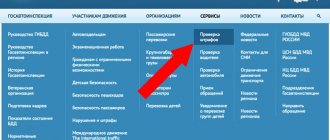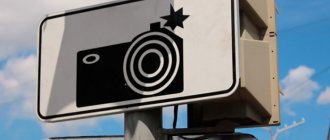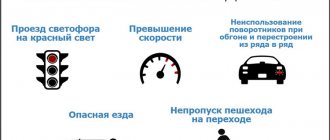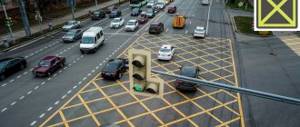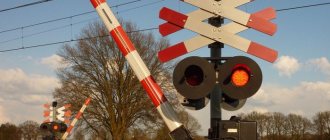What is it written for?
Let's consider in what case, for what and where exactly, as well as under what conditions this fine can be issued!
What and where?
So, if a waffle marking 1.26 is applied to an intersection, then you cannot go to it if a traffic jam has formed behind the intersection along the route of the car. Here's the markup:
Also at such an intersection there may be a corresponding sign 1.35, warning approaching drivers that there are “waffle” lines on it. This is what the sign looks like:
That is, if you drove into an intersection and were forced to stop, you may be issued a fine? But not in all cases.
Under what conditions?
These cases are clearly indicated in the traffic rules. So, a fine for waffle markings, that is, an intersection strictly marked with markings 1.26 or sign 1.35, can only be issued under the following two conditions:
- You are moving straight and a traffic jam has also formed while moving in the forward direction; if you turn or turn around, then according to the law there cannot be a fine for this;
- By stopping at the waffle markings, you created interference with cars driving in the direction transverse to you.
If at least one of them is not met, no punishment should follow. This is the main subtlety of the fine for “waffle”. For example, if you still stopped at the markings because of a traffic jam, but did not interfere with anyone, then penalties under the Administrative Code cannot be applied to you.
This is exactly the interpretation prescribed by clause 13.2 of the traffic rules:
13.2. It is prohibited to drive to an intersection, the intersection of roadways or a section of an intersection marked by marking 1.26 if there is a traffic jam ahead along the route that will force the driver to stop, creating an obstacle to the movement of vehicles in the transverse direction, with the exception of turning right or left in the cases established by these Rules.
Why do we need a new waffle iron marking?
Waffle markings look like a rectangle with a grid of diamonds inside. For its original design, motorists call it a waffle, or waffle iron.
Yellow markings at the intersection mean that drivers are prohibited from entering them when the traffic light turns red.
It was always forbidden by the rules to drive into an intersection where cars were piled up. However, most drivers ignored this: no one enforced the rule or fined anyone for violating it. The boundaries were not marked in any way, and problem areas were not monitored by traffic police inspectors or video cameras. The new markings, coupled with CCTV cameras, are designed to solve the problem of clogged roads and reduce traffic collapse in Moscow and other big cities.
The main advantage of the new waffle marking is its clarity. Now motorists see the problem area in advance and assess their risks in the event of a forced stop at a waffle when the traffic light turns red. They understand that they have a financial interest in complying with the rules for driving through intersections behind which traffic jams have formed, and do not create traffic jams on these sections of roads.
Can I catch it on camera?
Yes. The corresponding government decree on the introduction of waffle markings also provides for a change in the interpretation of the corresponding plate 8.23. Thus, according to the change, it is allowed to install a combination of signs 1.35 and 8.23:
However, as of May 21, 2021, there are no automatic recording cameras yet that could accurately recognize a stop on a waffle marking when a traffic jam has formed ahead and, most importantly, the fact of creating an obstacle as a condition of a fine for violating this marking.
How to drive through waffle intersections correctly
Stopping at waffle markings is prohibited when the traffic light turns red. The prohibition applies to driving in a straight direction or turning around. When turning to the right or left, motorists are allowed to complete the maneuver. So they will not create any interference for vehicles moving in the transverse direction at the permitting traffic light signal.
Let's look at typical traffic situations on busy road sections:
- During rush hour, you won't be able to make a U-turn without stopping at the waffle iron. It’s better to postpone the maneuver until the next intersection, otherwise you risk getting a fine for stopping inside the waffle section of the road.
- Whether driving straight or on a curve, make sure there is room for your car before crossing the intersection. If there is no space, you should wait until it appears, and then you can continue moving.
- Standing on the waffle markings is not allowed. Traffic regulations provide for only two valid reasons for which stopping within the boundaries of the waffle will not result in a fine: it is allowed to let pedestrians pass when turning and oncoming cars when turning left. In other situations, the camera will record your stop as a violation.
There are often road situations when a motorist, when turning, has to let oncoming cars pass, and during this time a traffic jam forms outside the boundaries of the waffle markings. In such a situation, the driver cannot pass. He is forced to stay within the boundaries of the waffle iron and pay a fine.
How to drive through an intersection without getting a fine?
There are a number of other subtleties with the newly introduced waffle markings. The point here, as usual, is the enforcement of legislation. The fact is that, as we already wrote above, cameras, in principle, are not able to determine whether you created an obstacle or not, not to mention the features of recording a stop and determining the maneuver.
Therefore, contrary to the official interpretation of the updated paragraph 13.2 of the traffic rules, the best solution at intersections with waffle markings is not to stop at all, so as not to get a fine from the camera.
Another nuance is that the traffic rules currently do not have a definition of the word “congestion”, and this is precisely the condition mentioned in paragraph 13.2 about the notorious waffle markings. What is considered as such, one car stopped after an intersection or a column of them, and how many cars should be in such a column as a criterion for congestion, the Rules do not say.
Fines for driving on waffle markings in 2021
Waffle markings at intersections are a new type of road marking in Russia, which appeared only in 2021. Until this year, this type was only experimental and was not introduced into traffic regulations. The main rule for all car owners is not to stop there. And if the stop occurs when the light turns red in your lane, the consequences can be serious, in the form of fines. Violations are recorded by CCTV cameras.
How to drive through an intersection correctly? Road intersections are places where cars cross in different directions. It is limited by traffic signs and regulated by traffic lights. Connects multiple destinations and regulates safe passage. In simple words, this is an area where roads connect and branch. Why do you need waffle markings (clause 1.26 of the traffic rules)? Traffic jams at road intersections are not uncommon. They block the exit of cars and spread congestion. This is why most accidents happen. Waffle markings and video cameras that record offenses will help prevent them. Experiments that were carried out in the capital 2 years ago showed the benefits of such markings, the number of accidents decreased significantly, and the number of traffic jams at intersections also decreased. Why can't you stop with waffle markings? The main reason is to prevent the traffic jam from spreading from the area where it formed to the neighboring street. The state is trying to ensure free passage for every motorist. The markings are intended to clear passage at the intersection, and not to allow traffic to accumulate at it. It is applied together with the sign 1.35, which indicates the presence of an intersection. It looks like a yellow square on a black background with two diagonal lines. If it is not there, the fine can be appealed in most cases.
Surveillance cameras on the markings. Monitoring traffic violations is a new form that should ensure the safety of drivers and pedestrians. Until recently, video cameras were not installed at intersections, but experience has shown that they are necessary. Now these clamps are equipped with new functions and are fully automated. With their help, many offenses are registered and appropriate fines are issued. What fines are imposed for violations of waffle markings? The fine for waffle markings will be 1000 rubles. This fine is issued to all violators for stopping at an intersection with markings. Stopping at an intersection is a possible source of traffic jams. The markings prevent free movement and create obstacles for exiting or entering outside the permitting effect of the traffic light.
Bottom line. At the moment, the law prohibits stopping at waffle markings. All violations are recorded by CCTV cameras, and they issue the required fine in the amount of 1000 rubles. Avoiding standing on line signs when the light is red is the main goal of waffle markings.
What is the waffle marking sign for?
Markings with a waffle pattern are needed to clearly indicate the territory into which a vehicle is prohibited from driving if there is a traffic jam ahead on the road. Before the adoption of the “waffle iron” law, the driver moved forward through the intersection, encountered a traffic jam on his way, and became an obstacle to the movement of cars moving in the transverse direction.
Moreover, the sign under discussion does not prohibit the driver from turning the car to the right or left, if this movement is possible according to current traffic regulations.
In fact, situations where drivers clog intersections with their cars and interfere with other cars occur quite often.
Authorities hope that the waffle iron, used in conjunction with a traffic camera, will discipline those drivers who usually try to get through the intersection as quickly as possible, but at the same time create a traffic jam for other cars due to their haste. Now motorists will have to think: wait a few seconds or then pay a fine for waffle markings.
However, the entry into force of the “waffle iron” provision does not mean that the condemned sign will appear in all populated areas of our country immediately from the beginning of May. The issue of applying images of this level on roads is decided by the municipalities of those cities in whose territory the waffle marking sign will be placed.
It is worth considering that the speed of response to new laws in different places in our country is different. Therefore, in some places, markings in the form of a waffle pattern have already appeared, but in other places the authorities have not yet gotten around to implementing this clause of the traffic rules.
But we can hope that during the summer of 2021, in most cities of the Russian Federation, a “waffle iron” will still be painted at intersections. After all, now is the season for updating signs on the roads; in winter they usually don’t do this.
What are waffle markings at intersections?
Waffle marking is a special pattern applied in yellow to part of the road in the form of a grid consisting of lines intersecting diagonally and having certain boundaries. The waffle marking sign on the territory of the Russian Federation was approved by a special government decree in October last year.
The pattern discussed should be used at road intersections regulated by traffic lights and where congestion often occurs. The definition of a “waffle iron” and other information about it is contained in the official Rules of the Road. The image of waffle diagonals can be used alone or together with the “Intersection Section” road sign. This sign must be used only in conjunction with markings. The “waffle iron” can be used both on ordinary intersecting roads and on roads with more complex intersections.
It remains to add that waffle markings have been tested in the capital of the Russian Federation as a pilot project since 2015. Also, a similar experiment was carried out on the territory of the Northern capital, the capital of the Urals and the capital of Tatarstan. The experience was considered successful, and now it is spreading throughout the entire territory of our vast country.
